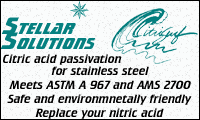
Curated with aloha by
Ted Mooney, P.E. RET

The authoritative public forum
for Metal Finishing 1989-2025

-----
Strip (remove) Copper Plating from Steel
Q. Hello Ted and the world wide gang.
I am on a quest to find a non-cyanide, non-chromate alternative for stripping of copper from steel parts. This is a post nitriding operation after the copper is used as a mask during nitriding. One attempt using 50 g/l ammonium persulfate, with acidification with sulphuric acid, did not turn out so well, to use British understatement. It started off OK with the copper slowly dissolving into the solution from the test pieces.
However, Mr Jekyll quickly turned into Mr Hyde, as, when I suspect, some iron under the copper dissolved into the solution and sent the solution into a thermal runaway effervescing nitrous oxide fumes and consuming the steel test pieces as well as the copper. I'll not be using that solution again!
So does anyone know of another system, hopefully, none proprietary, that can meet the above requirements, without the ammonium persulfate type reaction.
Thanks in advance for any help that anyone can give.
Mark Lees
- A dull grey rock in the Irish Sea
March 14, 2025
A. Hi Mark.
Decades ago my employer (M&T, now Atotech) installed two programmed hoist lines at a well known tool supplier to the oil-drilling industry in Houston Texas. The first line was for applying pyrophosphate copper plating to the tools before nitriding, the second line was for stripping it off after nitriding. Interestingly, the stripped copper was going to be recovered and reused in the first line. I was a young engineer designing & installing equipment with no knowledge of the chemistry, so I don't know what the stripping solution was, nor if the re-use of the copper actually worked out.
But I can assure you from this experience that reliable, continuous, high-production stripping of copper from heat treated parts can be done. Since recovery & reuse of the copper was planned, most likely the process was electrolytic. I've appended your inquiry to an earlier thread suggesting some alternative stripping solutions, and hopefully some kind & knowledgable soul will chime in ... because the only thing I recall from my visit 55 years ago is that a heat treatment plant in Houston in the summer was so damn hot you absolutely would not believe it 🙂
Luck & Regards,

Ted Mooney, P.E. RET
Striving to live Aloha
finishing.com - Pine Beach, New Jersey
A. Hi Mark,
A long, long time ago, when I was first starting out in the electrochemistry world, I developed a method of electro-stripping, a method was also patented by Lea Ronal back in the early 1990s, based on the same type of chemistry.
The solution was based on the pyrophosphate solution for copper plating, with the copper pyrophosphate not added, scrap copper anodes recycled as cathodes and the part made cathodic. Stripping times were down to 1-2 hours, and we had a stripping solution that lasted up to 5 years, rather than 6 weeks (as it was at the time, when using cyanides and proprietary salts in a purely immersion process). It cut down on process time and waste at the time.
Aerospace - Yeovil, Somerset, UK
![]() You guys have made me realize that (to the best of my knowledge) no book has ever been written about stripping. With so many platings, so many substrates, so many situations, I bet I'm not the only one who would love to see one.
You guys have made me realize that (to the best of my knowledge) no book has ever been written about stripping. With so many platings, so many substrates, so many situations, I bet I'm not the only one who would love to see one.
Luck & Regards,

Ted Mooney, P.E. RET
Striving to live Aloha
finishing.com - Pine Beach, New Jersey
I agree ted, Perhaps we should all contribute with all the things we do, for an editor to compile into printable form.
Best regards
Mark
- A rainy rock in the Irish sea
March 25, 2025
Thanks for your reply Brian,
Q. Can you please give me some more detail about the solution and current electric arrangements?
Thanks and best regards
Mark
- A rainy rock in the Irish sea
March 25, 2025
Hi Mark,
It's pushing my memory a bit, but is based on a typical copper pyrophosphate plating solution, minus the copper pyrophosphate, so typical make up would be around:
Potassium pyrophosphate - 150 g/l
Potassium nitrate - 2 g/l
Ammonia (concentrated) - 1ml/l
Temperature - around 50 °C
Current density - typically 1-2 A/dm2, but if memory serves me right, stripping could be accelerated by increasing the current to 5 A/dm2 without damaging the base material (never completed fatigue testing at that removal rate, so treat it with caution, although there is no reason I can think of for there to be an issue).
Aerospace - Yeovil, Somerset, UK
March 31, 2025
⇩ Related postings, oldest first ⇩
Q. I am looking for chemical or chemicals to strip 1 microns of copper plating from a nickel alloy material [Ni (70%), C (0.05), Si (0.15%), Mo (4.0%)] without affecting or etching the surface. I do not wish to use cyanide or a cyanide based chemical. Please recommend me the best way to solve this problem.
Fong
- Singapore
2004
A. Immersion in ammonium hydroxide (ammonia water) will dissolve copper in a short time and will not affect the nickel alloy. Odor is very strong and irritating, and disposal must be done in accordance with your local laws.
Guillermo MarrufoMonterrey, NL, Mexico
Q. Mr. Marrufo,
Seems like it doesn't strip the copper plating even using 28% concentrated ammonia
⇦ this on
eBay or
Amazon [affil links] water (without adding additional water). Any other ways to strip copper on nickel alloy without using cyanide.
Thanks
- Singapore
|
A. Try adding about 2-4% of 35% hydrogen peroxide.  Jeffrey Holmes, CEF Spartanburg, South Carolina A. One micron of copper should be no problem to ammonia (should remove it in less than one hour). If it is not working then it is not copper or has something else on top of it. Another possibility is to use anodic treatment part is (+) stainless steel is (-), 6 volts and 30% alkali in water (sodium or potassium hydroxide) but again this may not work if ammonium didn't. Guillermo MarrufoMonterrey, NL, Mexico |
A. You can use 150 gm sodium sulfide/15 gm sulfur/1 lit water solution (20 °C temp.)!
Good luck!
- Cerovski vrh Croatia
A. Sodium or Ammonium persulphate will work very well.

Lee Kremer
Stellar Solutions, Inc.
McHenry, Illinois

A. Your supplier can suggest a safe copper stripper. Or, as Mr. Lee mentioned, you can use persulphate as it etches copper. Or you can also go for mild hydrochloric acid with ferric chloride ⇦ this on eBay or Amazon [affil links] for slow stripping, but be careful since it is highly corrosive mixture.

Shafiuddin A. Mohammed
metal coating shop - Dubai, United Arab Emirates
October 31, 2009
Q. I have used a solution of ammonia with 10% hydrogen peroxide to strip copper alloy from steel parts. The solution turns blue and loses its effectiveness. Is there an easy way to remove the metals and reuse the solution? I've never worked in the industry, I'm only just learning how to brass plate.
Mike Dunn- Rochester, New York USA
December 27, 2016
A. Hi Mike.
Some suppliers have offered copper bright dipping systems which used sulphuric acid and peroxide at high temperature, with a slipstream recirculated to a cooling system to remove precipitated copper sulphate, to allow continuous or at least extended use of the stripping solution by removing the copper. Whether this has any hope of being helpful with ammonia and peroxide I don't know 🙂
Luck & Regards,

Ted Mooney, P.E. RET
Striving to live Aloha
finishing.com - Pine Beach, New Jersey
Q. Hey, I've been a plater for quite a while now. Here's the question. I was derusting my motorcycle gas tank. I used vinegar ⇦in bulk on eBay or Amazon [affil links] . Rinse well, fill with some steel BBs or nuts and washers, along with hydrogen peroxide. Agitate for a while drain and neutralize? It's a very small deposit of copper I can almost rub it off with finger; light touch of scotch brite immediately removes it but I have no way of getting inside the tank with anything.
Jesse Drum [returning]- Mpls Minnesota
February 3, 2017
A. Looking at the various options suggested in this thread over its lifetime, I think the persulphate option is still the least hazardous. (It ships hazmat due to being an oxidizer but isn't noxious to work with.)
(Adv.)
Please feel free to contact me if you are interested in a source for this.

Ray Kremer
Stellar Solutions, Inc.
McHenry, Illinois

A. Why not try putting a few handfuls of sand in the tank with some water and agitating it in sone way, even manually.
Peter Wells- Roodeport, South Africa
Q. Wanting to strip copper plate from a non-stainless, alloy steel (9310 per AMS 6365). The copper plating thickness varies over the part surfaces, however, some of which have no copper and some of which have up to 3 mils of copper plate.
Which solution will be most effective yet not damage/metallurgically change the underlying non-stainless steel base metal?
Thanks.
VP, Operations and Engineering - Gardena, CA
January 11, 2022
A. Hello Mike
There are a few proprietary strippers based on Nitrobenzene sulfonate salts. They are frequently marketed as Nickel strippers. When those strippers are mixed with Sodium Cyanide or some other alkaline salts, they will strip Nickel, Copper, and some other soft metals from steel (without damaging steel). Heating of the solution may be required. Try to contact your chemical supplier.
Also, it is possible to strip Copper electrolytically at 5-6V anodic (reversed) in a diluted mix of Sodium Cyanide and Sodium Hydroxide. Please note: any work with Cyanides requires relevant safety measures due to toxicity.
Good luck,
- Winnipeg, Canada
Q, A, or Comment on THIS thread -or- Start a NEW Thread
